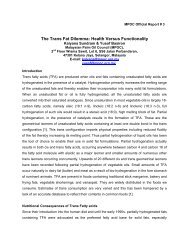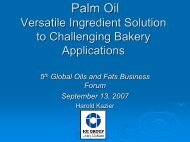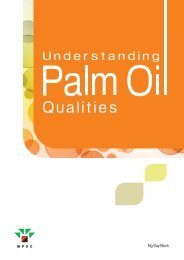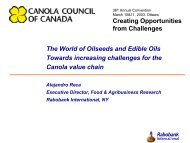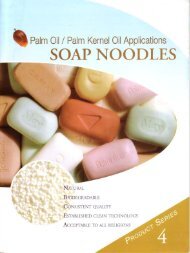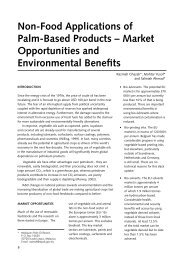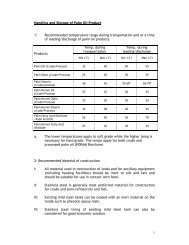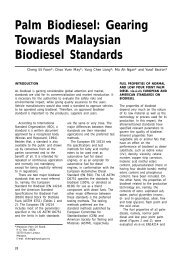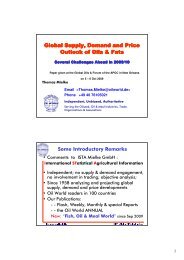SustainabilityThe Malaysian plantation crop system has great potentialfor integration with livestock, particularly with cattle,sheep and goats, but use of land has not beenoptimised. Integration of animals – particularly beef cattle –provides an economically and ecologically useful strategy onseveral fronts.The number of cattle reared under oil palm in Malaysia grewfrom 46,789 in 1994 to 56,178 in 1997, so plantations still haveplenty of suitable land for this purpose.animals for ticks and wounds. Serious treatment can be left to avisiting officer from the Veterinary Department, who wouldmake regular checks on the animals and ensure that they arefree of disease.Vaccination for foot-and-mouth disease is carriedout once a year, while deworming is done twice a year.Nature’s resourcesNature provides much of the resources required for cattlerearingon oil palm plantations, which are perfectly positioned interms of synergy.Research shows that that one hectare of grazing area in aplantation can accommodate one head of cattle. A moderatelysizedplantation with sufficient grazing grounds could thereforeaccommodate 500-1,000 head of cattle. Only plantations in hillyareas would find it difficult to rear cattle, because the grazinggrounds would be limited.The animals would also have difficultyin accessing, and grazing on, steep slopes.It is estimated that the vegetation under oil palm treescontributes up to 80% of the country’s forage resources. Thetrees are grown in rows, leaving a space of 5-7m between rows.These inter-rows are covered with vegetation such asleguminous cover crops, grasses, broad leaf species and fernsthat form a naturalised pasture and can be utilised as forage forlivestock production (Wahab, 2002).There are certain basic needs in rearing cattle on plantations.Paddocks must be designated. These are usually separated byelectrical fencing, constructed with insulated steel rods and threelengths of electrical wire.Workers then drive the cattle from onepaddock to another depending on the availability of feed.The estate supervisor has to make a daily check on the animals,but actual care can be left to the workers. Normally, one workercan look after 150-200 head of cattle, including treating theThere are about 60-79 plant species, of which about 70% arepalatable grasses like Axonopus compressus, Brachiaria mutica,Chysopogon aciculatus, Cyrtococcum oxyphyllum, Digitariaascendens, Eleusine indica, Ichaemum muticum, Ottochloa nodosa,Panicum repens and Paspalum conjugatum.The legumes consist ofCalapogonium mucunoides, Centrosoma pubescen, Desmodiumovalifolium, Desmodium triflorum and Pueraria phaseloides. Fernsinclude Lygodium flexuosum, Nephrolepis biserrata and Pteridiumesculentum. Some of the native pasture species are deemed toGLOBAL OILS & FATS BUSINESS MAGAZINE • VOL.5 ISSUE 1, 200819
Sustainabilityhave high nutritional value. Leguminouscover crops such as C. mucunoides, C.Pubescens and P. Phaseoloides, Assassinintrusa and Mikania cordata have highlevels of crude protein.The botanical composition of the foragechanges as the oil palm trees grow. In thefirst five years, grasses, legumes and broadleaf species dominate the undergrowth.The legumes become reduced after thefifth year, with ferns and non-edible broadleaf plants taking over. As the trees growand the canopy becomes thicker, it reducesthe amount of light that reaches theground.This results in the establishment ofmore shade-tolerant species.In terms of animal nutritionalrequirements, the edible resources aremore than adequate for cattle-grazing.During the first three years of the oilpalm tree crop, the undergrowth couldprovide a feed biomass of between2,000-3,000kg DM/ha/yr. This declines toabout 400-800kg DM/ha by the seventhyear and remains at this level untilapproximately the 20 th year. The feedvalue of the ground vegetation iscomparable to improved pasture grasses(Jalaludin, 1998).<strong>Oil</strong> palm biomass is another source of feed.A nine-year-old tree produces more than7,300kg of fronds per ha/yr. One-third ofthis could go into nutritious cattle feed,comprising 50% of fronds and 50% of palmkernel cake (Latif et al 2002). <strong>Palm</strong> oil millwaste can also be converted as feed. Thisfurther helps the recycling process, therebyremoving hazards to the environment fromindiscriminate disposal of waste.Economic usesLivestock-rearing would help curb thegrowth of weeds and grasses in the interrows,and overcome inherent problemsassociated with methods currently in use.One method is the planting of shorttermcash crops like bananas andvegetables, especially in smallerplantations.A main drawback of planting cash cropsis that some compete with, and stunt, thegrowth of oil palm trees. Another is thatthese crops take the place of usefulleguminous cover-crops that providenitrates and nitrogenous compounds tothe soil – in fact, intermediate cropsdeplete soil nutrients, which deprivessupply to the oil palm trees.The resultantpoor soil would pose a problem intoreplanting 20-25 years later. After shorttermcrops are harvested or removed,there is a possibility that the inter-rowswill remain barren, leading to extensiveerosion and depletion of the top layer ofthe soil.Another method is the application ofweedicides, which has adverse effects onplants and the soil. Immature oil palmplants could be accidentally sprayed withchemicals, which could result in damageor the trees being killed. Chemicals whichseep into the soil after rain could kill thenumerous micro-organisms that help inregenerating and enriching the soil.Livestock animals would eat palatableweeds and grasses in inter-rows.Plantations could save up to 40% of thecost of weedkillers and herbicides, as wellas on field maintenance.In addition, there is money to be madefrom rearing of cattle through breeding,providing young calves for replacement,and slaughtering. Cattle could be sold inbulk during festive seasons whenconsumer demand is higher or throughauctions to the highest bidder. An animalweighing 300kg could bring in RM900-1,000. After deducting RM750 to coverthe cost of feed, care and shelter, theplantation would make a profit of aboutRM200 per head.MPOC20GLOBAL OILS & FATS BUSINESS MAGAZINE • VOL.5 ISSUE 1, 2008



